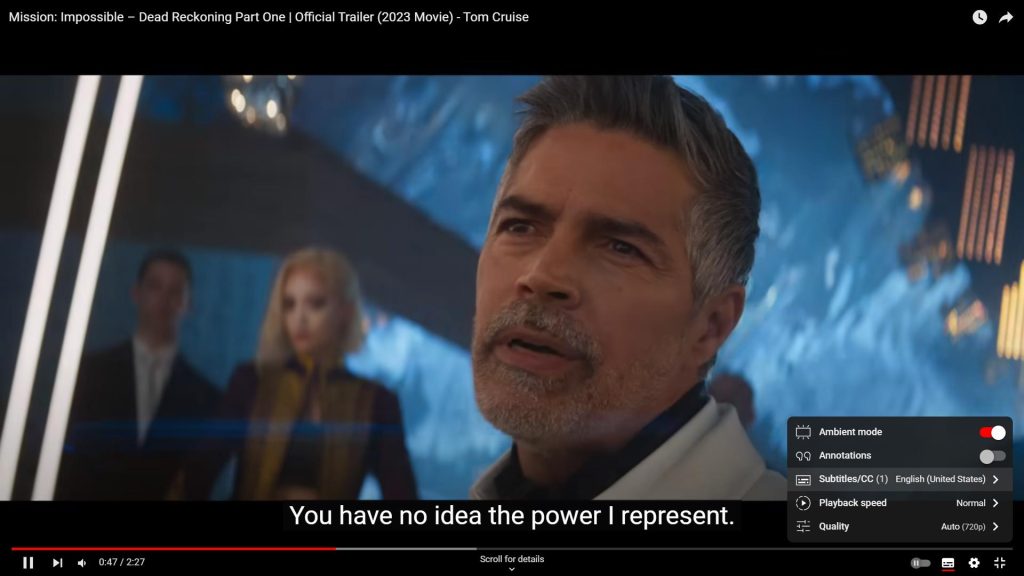In the expansive realm of multimedia, Captions and Subtitles wield considerable influence, facilitating widespread access to video content. Naturally, one may wonder: what sets them apart? The ongoing conversation surrounding captions and subtitles has prompted experts to provide definitions, though at times incomplete.
However, delving into the intricate nature of captions and subtitles reveals a depth beyond initial perception, underscoring the importance of recognizing their subtle distinctions when choosing the appropriate option for video content.
 Subtitles exhibit a wide range of styles, from white or yellow text with black borders to imitating the appearance of captions. Typically positioned at the bottom center of the screen, they ensure easy readability while minimizing any disruption to the viewing pleasure. By exploring the intricacies of both captions and subtitles, one can gain a deeper understanding of their distinct roles and significance in the multimedia domain, ultimately enhancing the viewing experience for a diverse audience.
Subtitles exhibit a wide range of styles, from white or yellow text with black borders to imitating the appearance of captions. Typically positioned at the bottom center of the screen, they ensure easy readability while minimizing any disruption to the viewing pleasure. By exploring the intricacies of both captions and subtitles, one can gain a deeper understanding of their distinct roles and significance in the multimedia domain, ultimately enhancing the viewing experience for a diverse audience.
 Subtitles showcase a wide range of stylistic options, spanning from white text outlined in black to mirroring the appearance of captions. Typically positioned at the bottom center of the screen, they prioritize readability while minimizing any disruptions to the viewer's immersion in the content.
Subtitles showcase a wide range of stylistic options, spanning from white text outlined in black to mirroring the appearance of captions. Typically positioned at the bottom center of the screen, they prioritize readability while minimizing any disruptions to the viewer's immersion in the content.
A Detailed Examination of Captions
Subtitles, emerging in the 1970s with the aim of enhancing the visual journey for individuals facing auditory obstacles, have since become an integral part of the American broadcasting landscape. In contrast, captions serve as written representations of video conversations, auditory effects, and melodies, initially designed for those with hearing impairments but now embraced by a wider audience. By default, captions adopt a white hue against a backdrop of black, yet viewers frequently tailor their appearance to match personal preferences. Normally, captions find their place at the center-bottom of screens; however, they may ascend if the lower portion is occupied by graphical elements or text.A Thorough Exploration of Subtitles
During the evolution from silent to "talkie" films in the 1930s, subtitles emerged as a means to engage foreign viewers who were unfamiliar with the language of the film. Primarily, subtitles serve to offer textual translations of video dialogue, catering to those who comprehend the audio but struggle with the spoken language. However, they also extend their support to individuals with hearing impairments or those who simply prefer content with subtitles. Subtitles exhibit a wide range of styles, from white or yellow text with black borders to imitating the appearance of captions. Typically positioned at the bottom center of the screen, they ensure easy readability while minimizing any disruption to the viewing pleasure. By exploring the intricacies of both captions and subtitles, one can gain a deeper understanding of their distinct roles and significance in the multimedia domain, ultimately enhancing the viewing experience for a diverse audience.
Subtitles exhibit a wide range of styles, from white or yellow text with black borders to imitating the appearance of captions. Typically positioned at the bottom center of the screen, they ensure easy readability while minimizing any disruption to the viewing pleasure. By exploring the intricacies of both captions and subtitles, one can gain a deeper understanding of their distinct roles and significance in the multimedia domain, ultimately enhancing the viewing experience for a diverse audience.
Why Captions and Subtitles Are Often Confused
The perplexity surrounding the distinction between Captions and Subtitles is a universally recognized challenge influenced by various factors. Let's briefly delve into how disparities in global terminology and the widespread embrace of SDH (Subtitles for the Deaf and Hard of Hearing) have added layers of complexity to discussions concerning captions and subtitles. In the domain of multimedia, where visual content reigns supreme, subtitles have become indispensable. However, their inception dates back to the 1930s, during the cinematic shift from silent to sound films. Initially, subtitles were designed to aid comprehension for those unacquainted with the film's original language. Subtitles primarily serve the purpose of providing textual renditions of video dialogue, catering to audiences who grasp the audio but struggle with the spoken language. Their significance transcends to individuals with hearing impairments or those who prefer to follow along with subtitles. Subtitles showcase a wide range of stylistic options, spanning from white text outlined in black to mirroring the appearance of captions. Typically positioned at the bottom center of the screen, they prioritize readability while minimizing any disruptions to the viewer's immersion in the content.
Subtitles showcase a wide range of stylistic options, spanning from white text outlined in black to mirroring the appearance of captions. Typically positioned at the bottom center of the screen, they prioritize readability while minimizing any disruptions to the viewer's immersion in the content.
